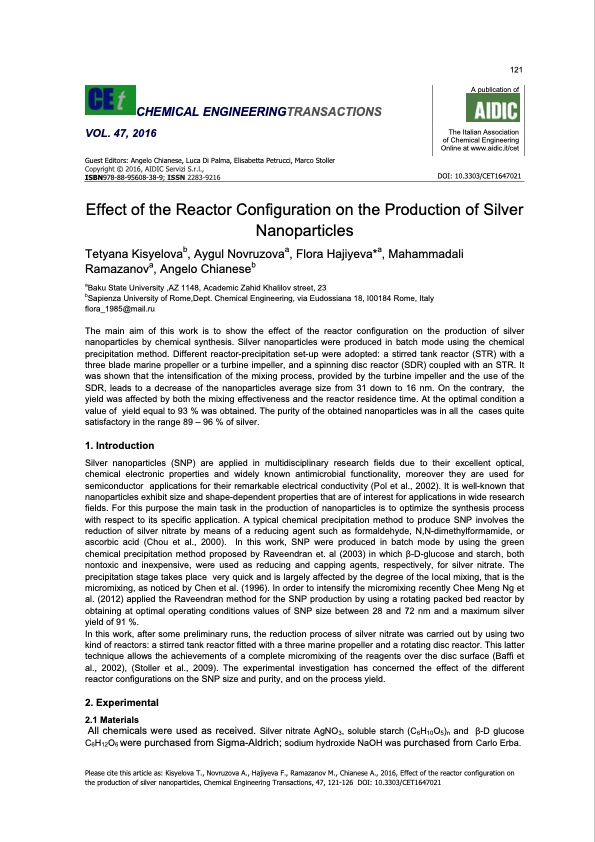
PDF Publication Title:
Text from PDF Page: 001
CHEMICAL ENGINEERINGTRANSACTIONS VOL. 47, 2016 Guest Editors: Angelo Chianese, Luca Di Palma, Elisabetta Petrucci, Marco Stoller Copyright © 2016, AIDIC Servizi S.r.l., ISBN978-88-95608-38-9; ISSN 2283-9216 121 A publication of The Italian Association of Chemical Engineering Online at www.aidic.it/cet DOI: 10.3303/CET1647021 Effect of the Reactor Configuration on the Production of Silver Nanoparticles Tetyana Kisyelovab, Aygul Novruzovaa, Flora Hajiyeva*a, Mahammadali Ramazanova, Angelo Chianeseb aBaku State University ,AZ 1148, Academic Zahid Khalilov street, 23 bSapienza University of Rome,Dept. Chemical Engineering, via Eudossiana 18, I00184 Rome, Italy flora_1985@mail.ru The main aim of this work is to show the effect of the reactor configuration on the production of silver nanoparticles by chemical synthesis. Silver nanoparticles were produced in batch mode using the chemical precipitation method. Different reactor-precipitation set-up were adopted: a stirred tank reactor (STR) with a three blade marine propeller or a turbine impeller, and a spinning disc reactor (SDR) coupled with an STR. It was shown that the intensification of the mixing process, provided by the turbine impeller and the use of the SDR, leads to a decrease of the nanoparticles average size from 31 down to 16 nm. On the contrary, the yield was affected by both the mixing effectiveness and the reactor residence time. At the optimal condition a value of yield equal to 93 % was obtained. The purity of the obtained nanoparticles was in all the cases quite satisfactory in the range 89 – 96 % of silver. 1. Introduction Silver nanoparticles (SNP) are applied in multidisciplinary research fields due to their excellent optical, chemical electronic properties and widely known antimicrobial functionality, moreover they are used for semiconductor applications for their remarkable electrical conductivity (Pol et al., 2002). It is well-known that nanoparticles exhibit size and shape-dependent properties that are of interest for applications in wide research fields. For this purpose the main task in the production of nanoparticles is to optimize the synthesis process with respect to its specific application. A typical chemical precipitation method to produce SNP involves the reduction of silver nitrate by means of a reducing agent such as formaldehyde, N,N-dimethylformamide, or ascorbic acid (Chou et al., 2000). In this work, SNP were produced in batch mode by using the green chemical precipitation method proposed by Raveendran et. al (2003) in which β-D-glucose and starch, both nontoxic and inexpensive, were used as reducing and capping agents, respectively, for silver nitrate. The precipitation stage takes place very quick and is largely affected by the degree of the local mixing, that is the micromixing, as noticed by Chen et al. (1996). In order to intensify the micromixing recently Chee Meng Ng et al. (2012) applied the Raveendran method for the SNP production by using a rotating packed bed reactor by obtaining at optimal operating conditions values of SNP size between 28 and 72 nm and a maximum silver yield of 91 %. In this work, after some preliminary runs, the reduction process of silver nitrate was carried out by using two kind of reactors: a stirred tank reactor fitted with a three marine propeller and a rotating disc reactor. This latter technique allows the achievements of a complete micromixing of the reagents over the disc surface (Baffi et al., 2002), (Stoller et al., 2009). The experimental investigation has concerned the effect of the different reactor configurations on the SNP size and purity, and on the process yield. 2. Experimental 2.1 Materials All chemicals were used as received. Silver nitrate AgNO3, soluble starch (C6H10O5)n and β-D glucose C6H12O6 were purchased from Sigma-Aldrich; sodium hydroxide NaOH was purchased from Carlo Erba. Please cite this article as: Kisyelova T., Novruzova A., Hajiyeva F., Ramazanov M., Chianese A., 2016, Effect of the reactor configuration on the production of silver nanoparticles, Chemical Engineering Transactions, 47, 121-126 DOI: 10.3303/CET1647021PDF Image | Reactor Configuration on the Production of Silver Nanoparticles

PDF Search Title:
Reactor Configuration on the Production of Silver NanoparticlesOriginal File Name Searched:
sdr-silver-nano.pdfDIY PDF Search: Google It | Yahoo | Bing
Turbine and System Plans CAD CAM: Special for this month, any plans are $10,000 for complete Cad/Cam blueprints. License is for one build. Try before you buy a production license. More Info
Waste Heat Power Technology: Organic Rankine Cycle uses waste heat to make electricity, shaft horsepower and cooling. More Info
All Turbine and System Products: Infinity Turbine ORD systems, turbine generator sets, build plans and more to use your waste heat from 30C to 100C. More Info
CO2 Phase Change Demonstrator: CO2 goes supercritical at 30 C. This is a experimental platform which you can use to demonstrate phase change with low heat. Includes integration area for small CO2 turbine, static generator, and more. This can also be used for a GTL Gas to Liquids experimental platform. More Info
Introducing the Infinity Turbine Products Infinity Turbine develops and builds systems for making power from waste heat. It also is working on innovative strategies for storing, making, and deploying energy. More Info
Need Strategy? Use our Consulting and analyst services Infinity Turbine LLC is pleased to announce its consulting and analyst services. We have worked in the renewable energy industry as a researcher, developing sales and markets, along with may inventions and innovations. More Info
Made in USA with Global Energy Millennial Web Engine These pages were made with the Global Energy Web PDF Engine using Filemaker (Claris) software.
Infinity Turbine Developing Spinning Disc Reactor SDR or Spinning Disc Reactors reduce processing time for liquid production of Silver Nanoparticles.
| CONTACT TEL: 608-238-6001 Email: greg@infinityturbine.com | RSS | AMP |